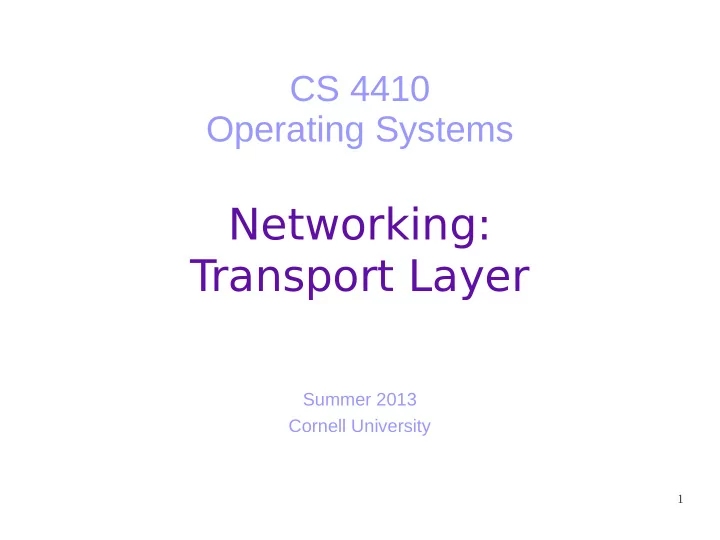

CS 4410 Operating Systems Networking: Transport Layer Summer 2013 Cornell University 1
Today ● What are the services that the Transport layer offers? ● Transport Layer ● Multiplexing-Demultiplexing ● UDP ● TCP ● Reliable transmission ● Congestion Control 2
Protocol Stack Computer B Computer A Message Application Application M Transport Transport Ht M Segment Network Network Datagram Hn Ht M Link Link Frame Hl Hn Ht M Physical Physical 3
Transport Layer ● It offers logical communication between processes. ● Networking processes think that they directly speak to each other. 4
Transport Layer Mission: Transfer a segment from one process to another. ● Services: ● Multiplexing – Demultiplexing ● Error Detection ● Reliable data transfer ● – It takes care of packet loss and reordering. Examples: UDP, TCP ● UDP offers the first two services and TCP offers all the services. ● Transport Layer Protocols are implemented only at terminal nodes ● (computers). Routers and switches do not exam this layer. ● 5
Multiplexing - Demultiplexing How does the Transport Layer know to which networking process it ● should forward the received data? How does the Transport Layer collect the data that the processes ● want to send and forward it to the network layer? Each process can create one or more sockets . ● Processes see sockets as the only gateway to the network . ● They can send or receive data only through them. In reality, they are structures of the OS that maintain valuable ● information for the connection. One field of the socket is its port number, a unique id in the ● system. Sockets are like file descriptors. When a process wants to send ● data, it invokes a system call, passing the socket and the pointer to data. 6
Multiplexing - Demultiplexing From the “other side” of the socket there is the Transport layer, implemented in the ● OS. The Transport Layer: ● takes the data from the process, ● splits the data into frames, ● reads the fields of the corresponding socket, ● creates the header for each frame (being based on the fields) ● and forwards the frame to the Network layer. ● This process is called Multiplexing . ● When a frame is forwarded from the Network Layer to the Transport Layer, the latter ● checks the header, identifies the port number of the socket-destination and forwards the data there. This process is called Demultiplexing . ● 7
Multiplexing - Demultiplexing ● The fields that are stored in the socket depend on which Transport protocol we use. ● UDP: port number of the source, port number of the destination. ● TCP: port number of the source, port number of the destination, IP address of the source, IP address of the destination. 8
UDP ● User Datagram Protocol ● Services: Multiplexing-Demultiplexing, Error detection. ● It is so light that the process “roughly” talks directly to the Network layer. ● It is not reliable, but it is fast. ● Usage: DNS, media transfer. Source port number Destination port number Length Checksum Data 9
TCP Transmission Control Protocol ● Connection-oriented ● The involved processes first establish a connection, through ● handshaking, and then they exchange data. TCP offers full-duplex service. ● Both processes can send data after the connection establishment. ● TCP offers point-to-point connection. ● Only two remote processes take part in one connection. ● TCP offers reliable communication and congestion control. ● 10
TCP segment 11
TCP Handshake SYN SYN, ACK of SYN ACK of SYN 12
TCP ● Reliability → all the data reaches the destination ● The destination should acknowledge the received segments to the source. ● Every TCP segment has: Sequence number = number of the first byte in the segment. ● Acknowledgement number = number of the next byte that the host ● expects. 1 st segment 2 nd segment 0 1 ... 1000 .. ... 1999 499999 13 text
TCP Seq=42, ACK=79, data='C' Seq=79, ACK=43, data='W' Seq=43, ACK=80 14
TCP: Retransmission ● What happens when a segment is lost or broken? ● No acknowledgment. ● The source waits for a specific time period and then it retransmits the segment. ● How long does it have to wait? 15
TCP Windows ● Instead of waiting for the acknowledgment of one frame before sending the next one, the source should send a window of frames. DATA, id=17 DATA, id=18 DATA, id=19 DATA, id=20 ACK 17 ACK 18 ACK 19 ACK 20 16
TCP Congestion Control ● TCP Increases its window size as long as no packets are dropped (linearly). ● It halves the window size when a packet drop occurs. A packet drop is evident from the acknowledgements ● ● Therefore, it will slowly build up to the max bandwidth, and hover around the max. It doesn’t achieve the max possible though ● Instead, it shares the bandwidth well with other TCP connections ● ● This linear-increase , exponential backoff in the face of congestion is termed TCP-friendliness. 17
TCP Congestion Control Max Bandwidth Bandwidth Time 18
TCP Slow Start ● Linear increase takes a long time to build up a window size that matches the link bandwidth*delay. ● Most file transactions are not long enough. ● Consequently, TCP can spend a lot of time with small windows, never getting the chance to reach a sufficiently large window size. ● Fix: Allow TCP to build up to a large window size initially by doubling the window size until first loss . 19
TCP Slow Start Max Bandwidth Bandwidth Time 20
Today ● What are the services that the Transport layer offers? ● Transport Layer ● Multiplexing-Demultiplexing ● UDP ● TCP ● Reliable transmission ● Congestion Control 21
Recommend
More recommend